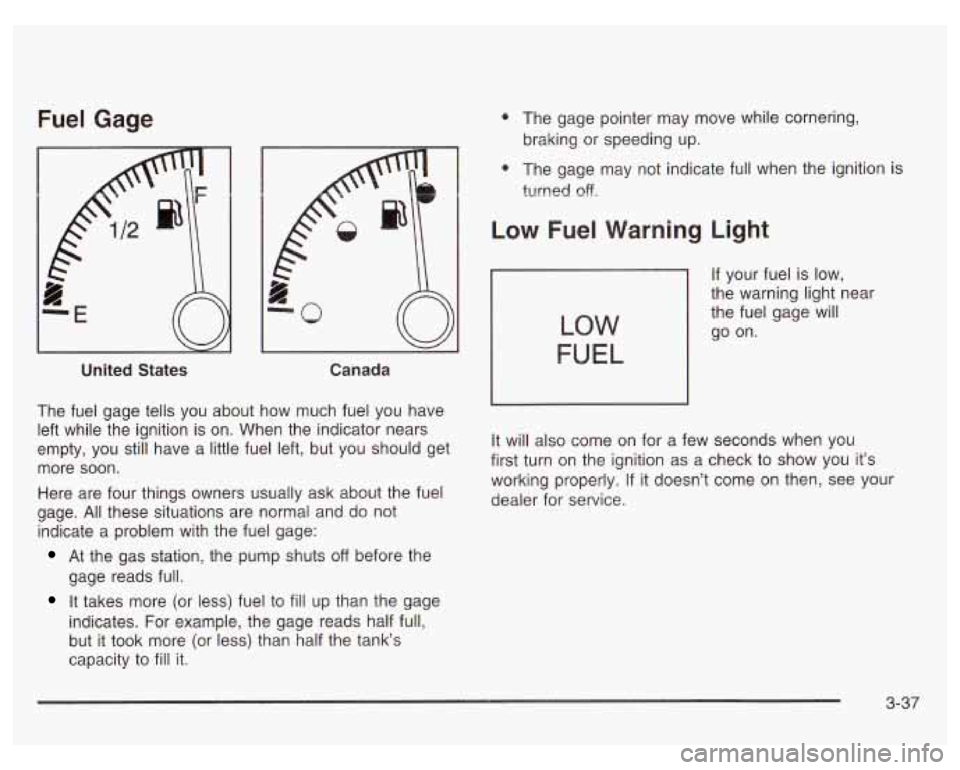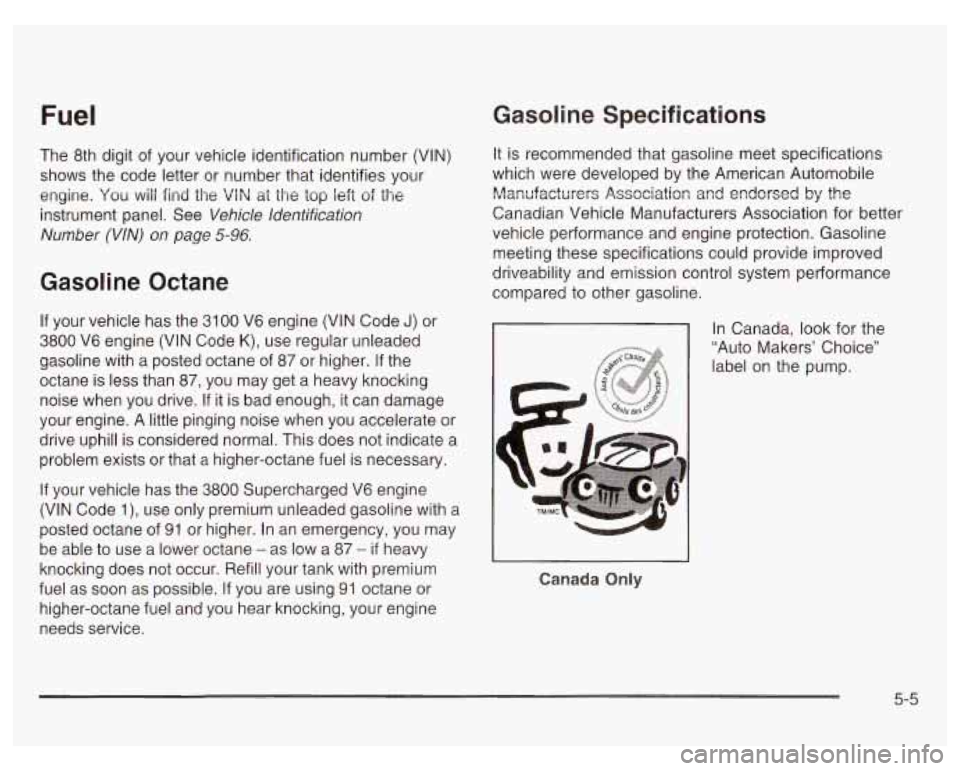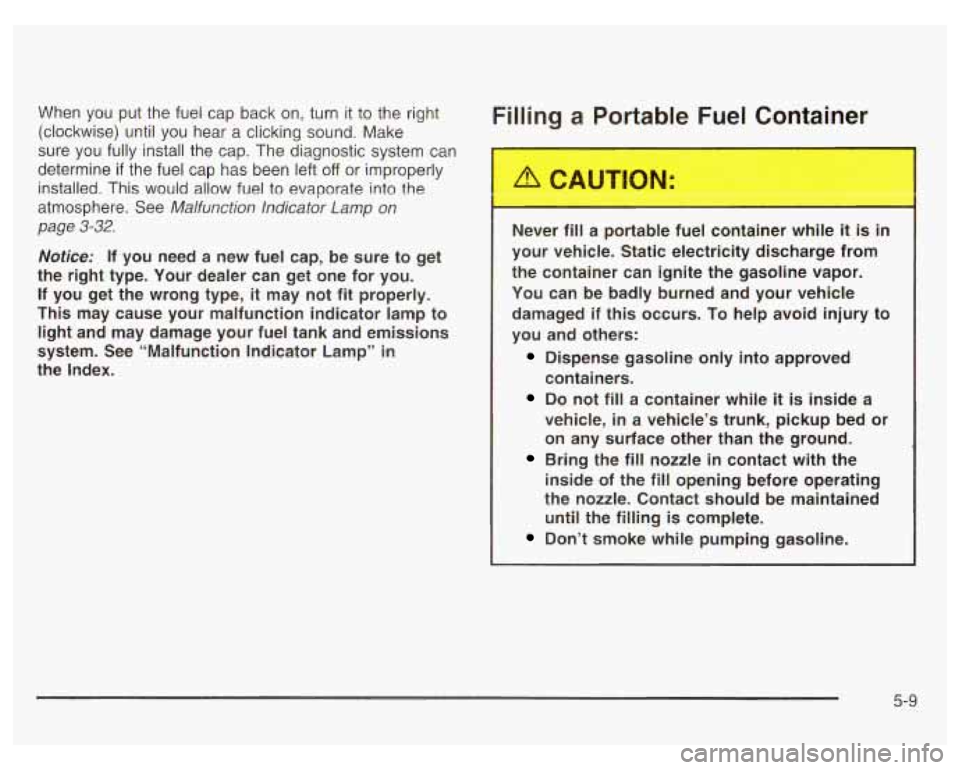Page 158 of 378

Fuel Gage
United States Canada
The fuel gage tells you about how much fuel you have
left while the ignition is on. When the indicator nears
empty, you still have a little fuel left, but you should get
more soon.
Here are four things owners usually ask about the fuel
gage.
All these situations are normal and do not
indicate a problem with the fuel gage:
At the gas station, the pump shuts off before the
gage reads full.
It takes more (or less) fuel to fill up than the gage
indicates. For example, the gage reads half full,
but it took more (or less) than half the tank‘s
capacity to
fill it.
0 The gage pointer may move while cornering,
braking or speeding up.
0 The gage may not indicate full when the ignition i?
turned off.
Low Fuel Warning Light
If your fuel is low,
the warning light near
the fuel gage will
go on.
LOW
FUEL
It will also come on for a few seconds when you
first turn on the ignition as a check to show you it’s
working properly.
If it doesn’t come on then, see your
dealer for service.
3-37
Page 230 of 378

Gasoline Specifications
The 8th digit of your vehicle identification number (VIN)
shows the code letter or number that identifies your
engine. You will find the ViN at the top left of the
instrument panel. See Vehicle Identification
Number (VIN) on page
5-96.
Gasoline Octane
If your vehicle has the 31 00 V6 engine (VIN Code J) or
3800 V6 engine (VIN Code
K), use regular unleaded
gasoline with a posted octane of 87 or higher.
If the
octane is less than 87, you may get a heavy knocking
noise when you drive. If
it is bad enough, it can damage
your engine. A little pinging noise when you accelerate or
drive uphill is considered normal. This does not indicate
a
problem exists or that a higher-octane fuel is necessary.
If your vehicle has the 3800 Supercharged V6 engine
(VIN Code I), use only premium unleaded gasoline with
a
posted octane of 91 or higher. In an emergency, you may
be able
to use a lower octane - as low a 87 - if heavy
knocking does not occur. Refill your tank with premium
fuel
as soon as possible. If you are using 91 octane or
higher-octane fuel and you hear knocking, your engine
needs service. It
is recommended that gasoline meet specifications
which were developed by the American Automobile
Manufacturers Association and endorsed by the
Canadian Vehicle Manufacturers Association for better
vehicle performance and engine protection. Gasoline
meeting these specifications could provide improved
driveability and emission control system performance
compared
to other gasoline.
Canada Only
In Canada, look for the
“Auto Makers’ Choice”
label on the pump.
5-5
Page 233 of 378
While refueling, let the fuel
cap hang by the tether
below the fuel
fill opening.
To remove the fuel cap, turn it slowly to the left
(counterclockwise). The fuel cap has a spring in it;
if you let go of the cap too soon, it will spring back to
the right.
If you get fuel on yourself and then something
ignites
it, you could be badly burned. Fuel can
spray out on you
if you open the fuel cap too
quickly. This spray can happen
if your tank is
nearly full, and is more likely in hot weather.
Open the fuel cap slowly and wait for any “hiss” noise
to stop. Then unscrew the cap
all the way.
Be careful not to spill fuel. Clean fuel from painted
surfaces as soon as possible. See Cleaning the Outside
of Your Vehicle on page 5-97. When filling the tank
do not overfill by squeezing in much more fuel after the
pump shuts
off.
5-8
Page 234 of 378

When you put the fuel cap back on, turn it to the right
(clockwise) until you hear a clicking sound. Make
sure you fully install the cap. The diagnostic system can
determine
if the fuel cap has been left off or improperly
installed. This would allow fuel to evaporate into
the
atmosphere. See Malfunction Indicator Lamp on
page
3-32.
Notice: If you need a new fuel cap, be sure to get
the right type. Your dealer can get one for you.
If you get the wrong type, it may not fit properly.
This may cause your malfunction indicator lamp to
light and may damage your fuel tank and emissions
system. See “Malfunction Indicator Lamp” in
the Index.
Filling a Portable Fuel Container
~ .-ver fil. - portable fL-- cc..-ainer while it is in
your vehicle. Static electricity discharge from
the container can ignite the gasoline vapor. You can be badly burned and your vehicle
damaged if this occurs.
To help avoid injury to
you and others:
Dispense gasoline only into approved
containers.
Do not fill a container while it is inside a
vehicle,
in a vehicle’s trunk, pickup bed or
on any surface other than the ground.
Bring the fill nozzle in contact with the
inside of the fill opening before operating
the nozzle. Contact should be maintained
until the filling is complete.
Don’t smoke while pumping gasoline.
5-9